Sha W., Malinov S. Titanium Alloys: Modelling of Microstructure, Properties and Applications
Подождите немного. Документ загружается.

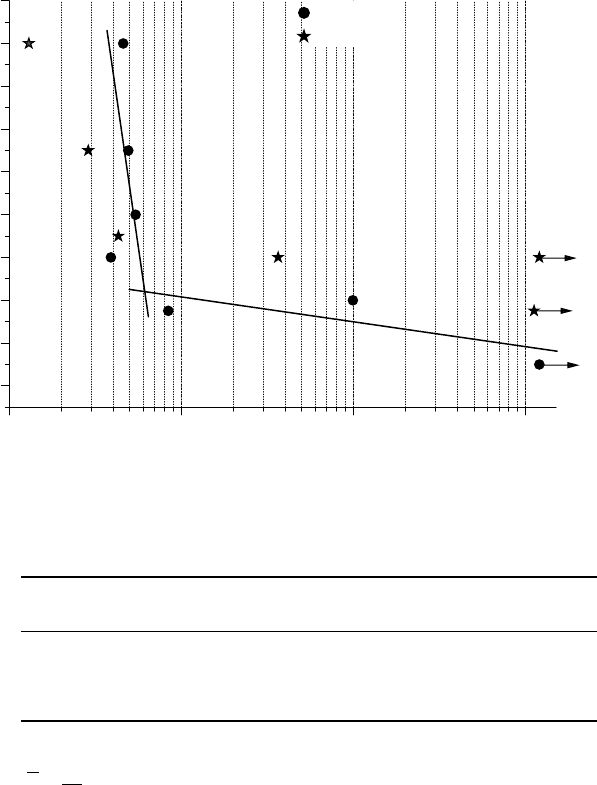
Surface gas nitriding: mechanical properties, morphology 473
Z
N
Z
i
N
i
=
1
=1
Σ
[17.2]
After nitriding, there are compound layers formed on the surface, mainly
consisting of titanium nitride, discussed in the next section. On the top of
that layer, a thin oxide film is formed. These films have a very high surface
roughness, >1 µm, that it is impossible to measure by atomic force microscopy
(AFM). That is the reason why they have to be removed in order to perform
the roughness measurements. The data for R
a
are given in Table 17.1.
There is an increase in surface roughness after gas nitriding at 950 °C for
5 hours. For the roughest sample, ground with abrasive paper #220, the
increase of R
a
is not significant whereas for smoother samples ground with
abrasive paper #2400 or polished, which have lower initial roughness, R
a
Reference
Nitrided
10
4
10
5
10
6
10
7
Cycles to failure
σ (MPa)
420
400
380
360
340
320
300
280
260
240
17.18
Fatigue data for CP-Ti in reference condition and after nitriding.
Table 17.1
Roughness of Ti-6Al-2Sn-4Zr-2Mo under different initial surface
conditions before and after nitriding at 950 °C for 5 hours
Initial surface preparation
R
a
before nitriding
R
a
after nitriding
(µm) (µm)
Abrasive paper #220
0.402
–0.115
+0.126
0.449
–0.097
+0.270
Abrasive paper #2400
0.070
–0.023
+0.025
0.266
–0.017
+0.021
Polished
1
/
4
µm
0.036
–0.007
+0.007
0.290
–0.087
+0.074
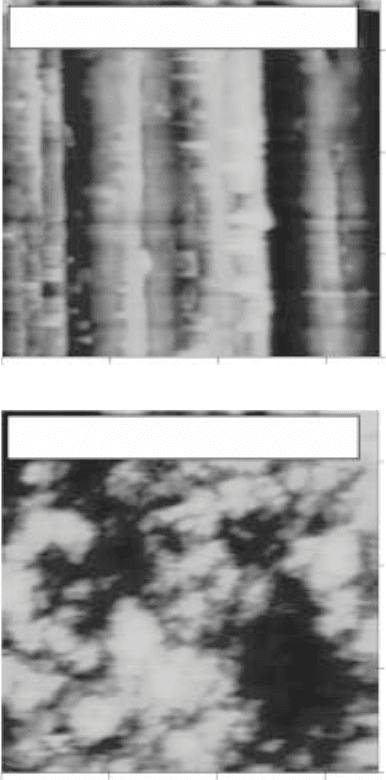
Titanium alloys: modelling of microstructure474
increases up to eleven times. After nitriding the smoother samples, they
show similar values of R
a
, whereas the roughest sample has much higher
roughness, obviously due to the difference in the initial roughness. The
surface morphology is presented by 2D and 3D images in Figs. 17.19 and 17.20.
(a) Z scale = 2 µm,
R
a
= 0.287 µm
0 20.0 40.0 60.0
µm
60.0
40.0
20.0
0
(b) Z scale = 2 µm,
R
a
= 0.358 µm
0 20.0 40.0 60.0
µm
60.0
40.0
20.0
0
17.19
Surface morphology of Ti-6Al-2Sn-4Zr-2Mo (a, c and e) before
and (b, d and f) after gas nitriding at 950 °C for 5 hours. (a) and (b)
Abrasive paper #220; (c) and (d) abrasive paper #2400; (e) and (f)
polished. The lightest area corresponds to the highest points in the
alloy surface, but there is no quantitative calibration of the
brightness scheme.

Surface gas nitriding: mechanical properties, morphology 475
(c) Z scale = 0.5 µm,
R
a
= 0.047 µm
0 20.0 40.0 60.0
µm
60.0
40.0
20.0
0
(d) Z scale = 2 µm,
R
a
= 0.261 µm
0 20.0 40.0 60.0
µm
60.0
40.0
20.0
0
17.19
Continued
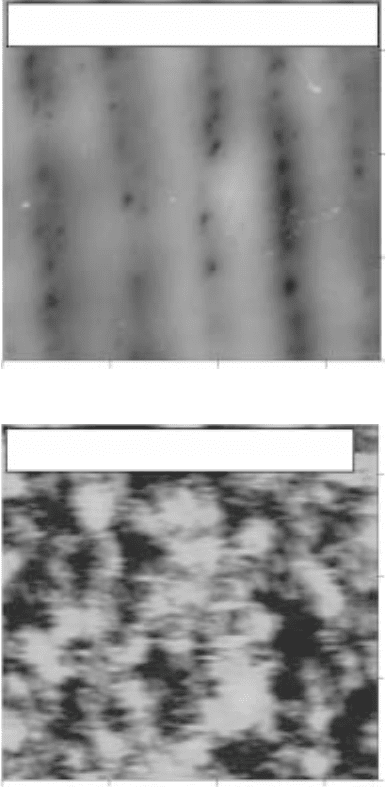
Titanium alloys: modelling of microstructure476
Table 17.2 shows the influence of the processing parameters on the surface
roughness after gas nitriding. The surface roughness increases with the time
prolongation from 3 to 5 hours at 950 °C, but there is no significant change
of the surface roughness with the increase of temperature from 950 to 1050 °C.
At the same time, there is a huge increase of R
a
(25 times) after treatment at
950 °C for 1 hour. This is because the surface oxide layer and the layer
underneath have a good adhesion so it is difficult to remove the very top
17.19
Continued
(e) Z scale = 0.5 µm,
R
a
= 0.022 µm
0 20.0 40.0 60.0
µm
60.0
40.0
20.0
0
(f) Z scale = 2 µm,
R
a
= 0.222 µm
0 20.0 40.0 60.0
µm
60.0
40.0
20.0
0
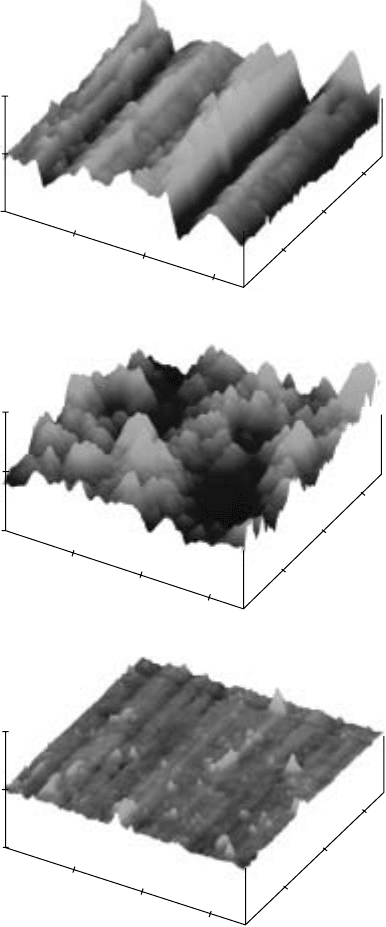
Surface gas nitriding: mechanical properties, morphology 477
20
40
60
µm
(a)
20
40
60
µm
(b)
20
40
60
µm
(c)
17.20
3D images of the surface morphology of Ti-6Al-2Sn-4Zr-2Mo (a,
c and e) before and (b, d and f) after gas nitriding at 950 °C for 5
hours. (a) and (b) Abrasive paper #220; (c) and (d) abrasive paper
#2400; (e) and (f) polished. The
Z
scale for all images is 2 µm/
division.

Titanium alloys: modelling of microstructure478
20
40
60
µm
(d)
20
40
60
µm
(e)
20
40
60
µm
(f)
17.20
Continued

Surface gas nitriding: mechanical properties, morphology 479
layer. The surface oxide layer has much higher surface roughness. The surface
morphology is presented by 2D and 3D images in Figs. 17.21 and 17.22.
17.3.2 Phase modifications and microstructure
As discussed in Chapter 16, when the alloys were in an active nitrogen
atmosphere at high temperature, the nitrogen absorbed at the surface diffused
into the material, forming different nitrogen compounds. As a result of the
nitriding process, a nitrided layer is formed that consists of a compound
layer on the surface of the material, which is mainly composed of titanium
nitride, followed by a diffusion zone which is composed of an interstitial
solution of nitrogen in the hcp α titanium phase, α-Ti(N). More details are
given in Chapter 16.
The change of the surface roughness is related to the phase transformations
that took place during gas nitriding, as revealed in diffraction patterns (Fig.
17.23).
After gas nitriding at 950 °C for 3 and 5 hours and at 1050 °C for 5 hours,
the compound layer consists of titanium nitride and a small amount of titanium
oxide. After gas nitriding at 950 °C for 1 hour, the surface layer consists
mainly of TiO
2
, because, as mentioned above, the top oxide film was not
removed. There are two possible reasons for this oxide film formation and
they are discussed in Chapter 16.
Optical images reveal the difference in the microstructure of the alloy
nitrided at different temperatures and for different times (Fig. 17.24).
As discussed in Chapter 16, after gas nitriding of the alloy at 950 °C, the
nitrided layer has a homogeneous microstructure, and its thickness increases
with increase of the nitriding time. This can be seen from the micrographs in
Fig. 17.24a–c. By increasing the nitriding temperature to 1050 °C, an irregular
needle structure is formed. In this case, it is difficult to define the layer
thickness from the microstructure. The grain growth at the higher nitriding
temperature is because 1050 °C is above the β-transus temperature for this
alloy (see Chapter 16).
Table 17.2
Roughness of polished Ti-6Al-2Sn-4Zr-
2Mo under different nitriding conditions
Nitriding condition
R
a
after nitriding (µm)*
950 °C, 1 hour
0.894
– 0.091
+0.081
950 °C, 3 hours
0.167
– 0.019
+0.015
950 °C, 5 hours
0.290
–0.087
+0.074
1050 °C, 5 hours
0.282
– 0.017
+0.032
*The roughness before nitriding is
0.036
– 0.007
+0.007
µm
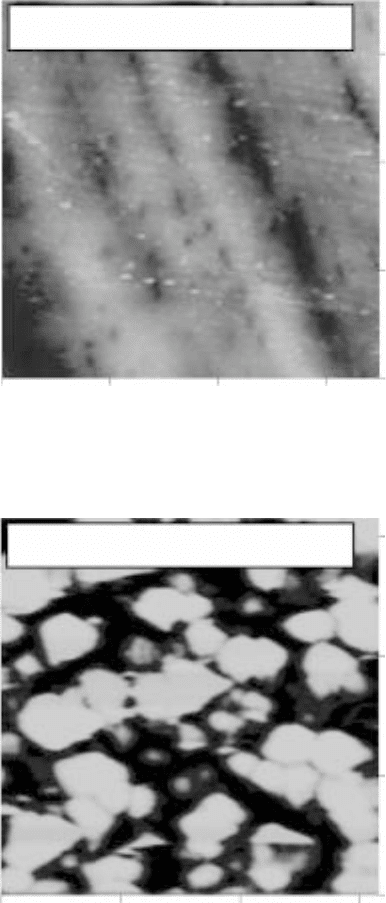
Titanium alloys: modelling of microstructure480
(a) Z scale = 2 µm,
R
a
= 0.035 µm
0 20.0 40.0 60.0
µm
60.0
40.0
20.0
0
(b) Z scale = 2 µm,
R
a
= 0.803 µm
0 20.0 40.0 60.0
µm
60.0
40.0
20.0
0
17.21
Surface morphology of polished Ti-6Al-2Sn-4Zr-2Mo (a, c, e
and g) before and (b, d, f and h) after gas nitriding at different
temperatures and for different periods of time. (a) and (b) 950 °C,
1 hour; (c) and (d) 950 °C, 3 hours; (e) and (f) 950 °C, 5 hours; (g) and
(h) 1050 °C, 5 hours.

Surface gas nitriding: mechanical properties, morphology 481
(c) Z scale = 2 µm,
R
a
= 0.033 µm
0 20.0 40.0 60.0
µm
60.0
40.0
20.0
0
(d) Z scale = 2 µm,
R
a
= 0.184 µm
0 20.0 40.0 60.0
µm
60.0
40.0
20.0
0
17.21
Continued

Titanium alloys: modelling of microstructure482
(f) Z scale = 2 µm,
R
a
= 0.202 µm
0 20.0 40.0 60.0
µm
60.0
40.0
20.0
0
(e) Z scale = 2 µm,
R
a
= 0.020 µm
0 20.0 40.0 60.0
µm
60.0
40.0
20.0
0
17.21
Continued
